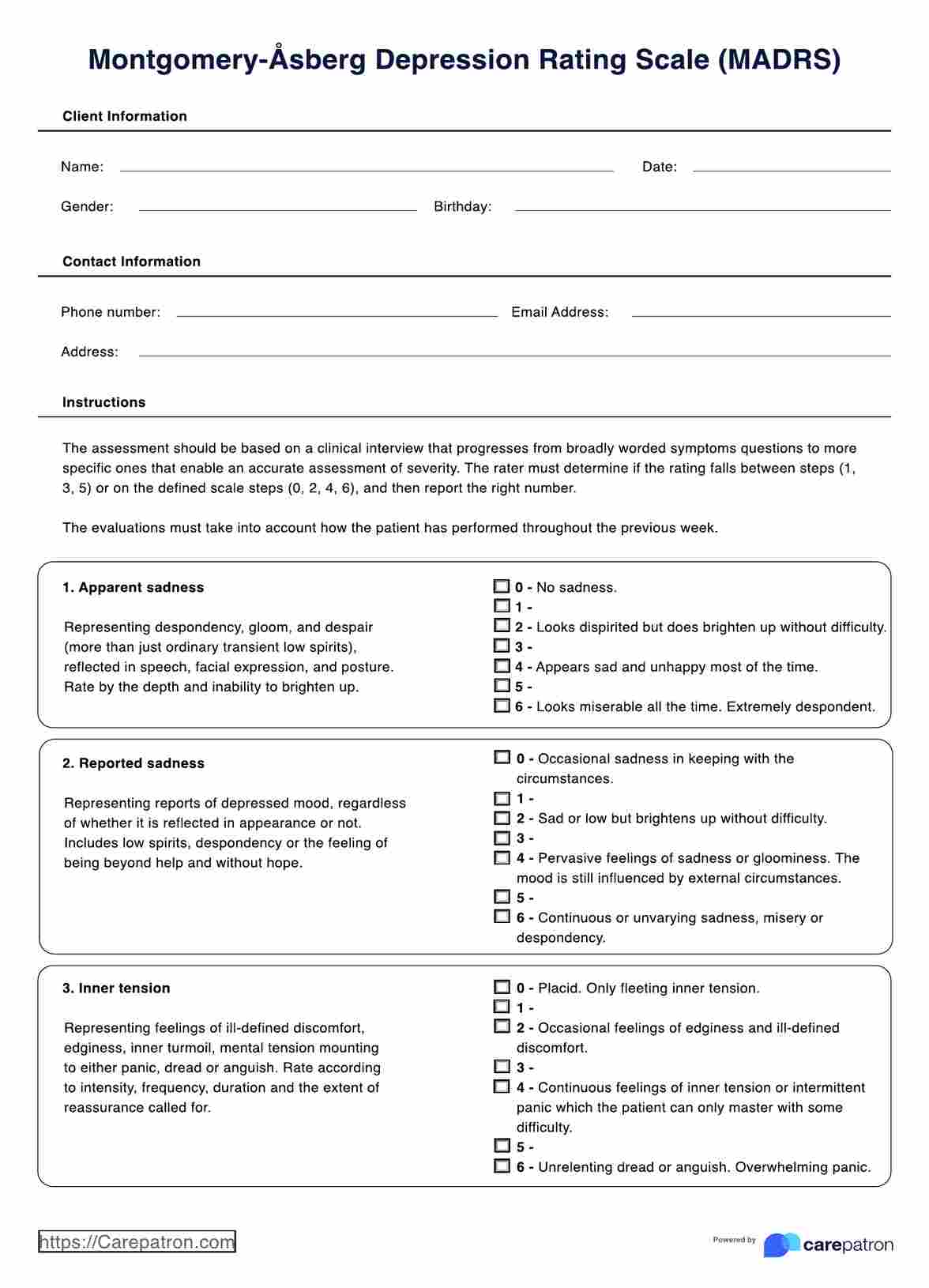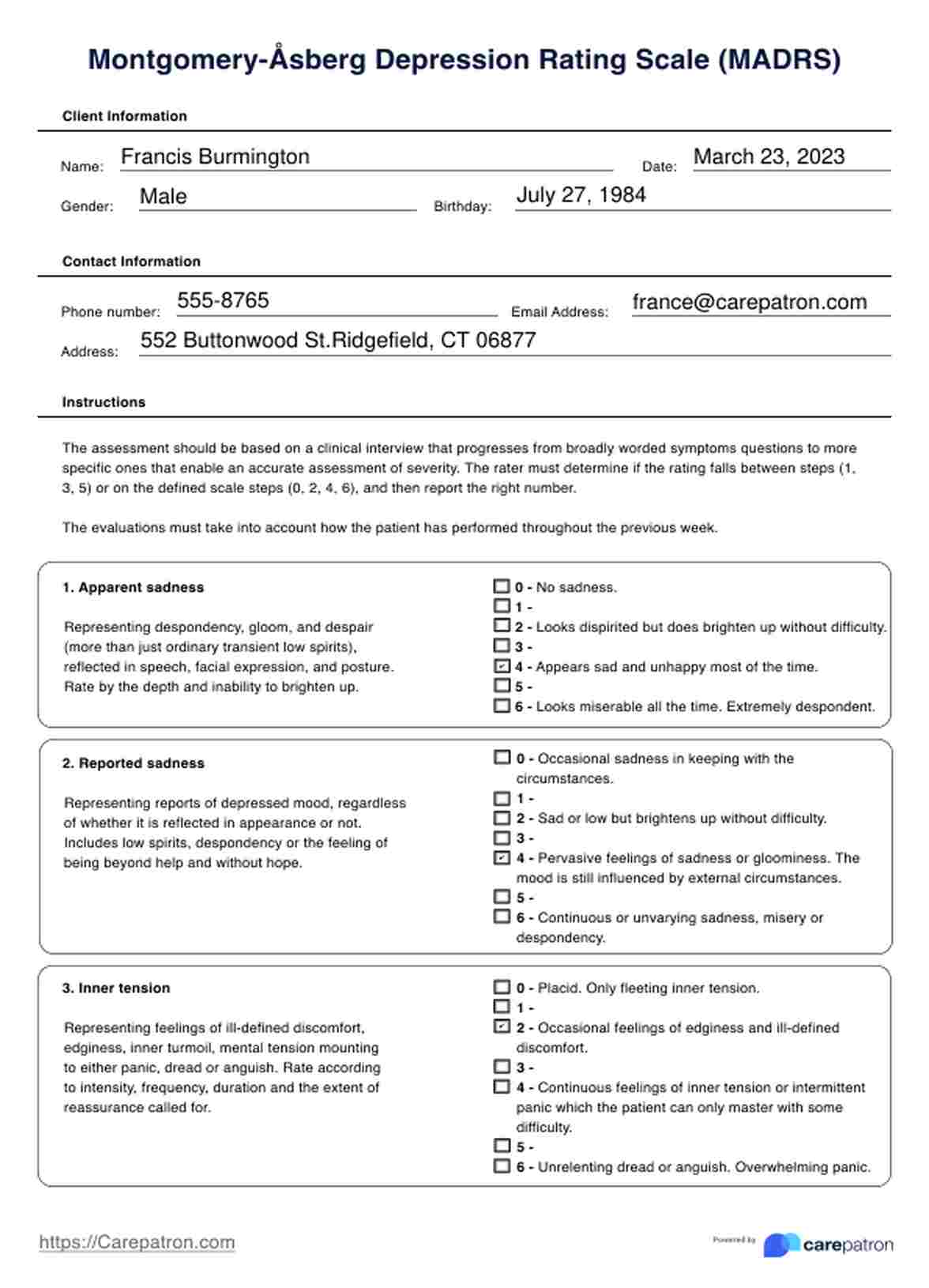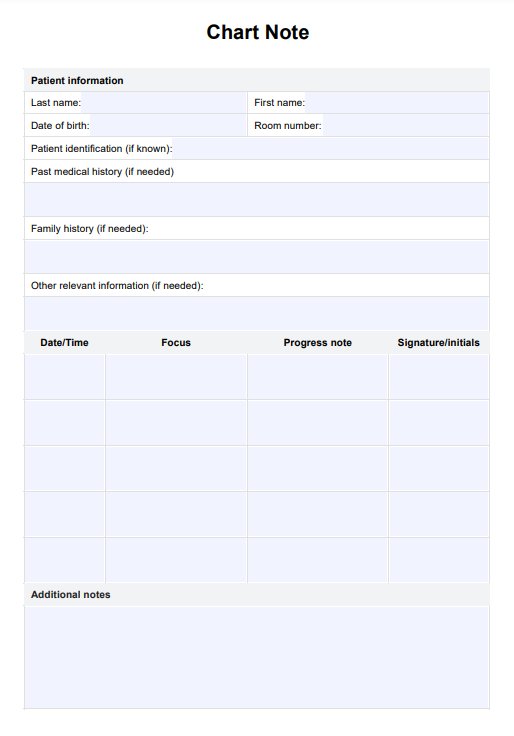Montgomery–Åsberg Depression Rating Scale
Use this Montgomery–Åsberg Depression Rating Scale to evaluate the depressive symptoms in your client and develop an effective treatment plan.


What is a Montgomery–Åsberg Depression Rating Scale (MADRS)?
The MADRS is a depression scale designed to be a widely-used psychological assessment tool used to assess the severity of affective disorders like major depressive disorder and depression in adults. The MADRS consists of a 10-item patient health questionnaire that rates various symptoms of depression, including mood, guilt, suicidal ideation, sleep, appetite, concentration, and energy levels.
Each item is rated on a scale of 0 to 6, with higher scores indicating more severe symptoms. You may consider using either the MADRS or the Hamilton Depression Rating Scale (Hamilton rating scale) as a geriatric depression scale for older people.
The ten items on the MADRS S Test are finished during a clinical interview. The MADRS contains the following items:
- Seeming melancholy
- Expressed sadness
- Internal angst
- Decreased sleep
- Diminished appetite
- Concentration difficulties
- Lassitude
- Incapable of feeling
- Negative attitudes
- Suicide ideation
The MADRS was initially released without examples of questions that physicians may use to get the necessary data to rate the components. The Structured Interview Guide for the MADRS (SIGMA), created by Williams and Kobak in 2008, offers structured questions that must be asked exactly as they are written to ensure administration standardization. If necessary, follow-up questions are also provided to define symptoms further.
Montgomery–Åsberg Depression Rating Scale Template
Montgomery–Åsberg Depression Rating Scale Example
How to use this test?
Step 1: Download the Montgomery–Åsberg Depression Rating Scale Test
On several websites, you can access the Hospital Anxiety and Depression Scale Test without charge. Patients can answer it digitally or use it as printed material for easy access.
Step 2: Explain the assessment
Ensuring the patient comprehends both the requirements and the evaluation tool's content. The attending physician should provide the patient with answers to all questions honestly and comfortably.
Step 3: Note your observations
While responding to the evaluation tool, keep an eye out for the patient's pattern of behavior. A doctor will be able to identify nonverbal and non-physical signs that contribute to anxiety and depression through observation.
Step 4: Compile
Get all relevant information and carefully review it. Analyze the test results to determine whether patients need extra attention for their physical and mental health requirements.
Step 5: Provide the best care you can
The next step is ensuring the patient receives the necessary care if anxiety and depression symptoms are confirmed. It should be guaranteed that their current medications won't worsen their mental health condition before they are recommended for long-term support.
When would you typically use this Montgomery–Åsberg Depression Rating Scale Assessment?
Here are some instances when this comprehensive psychopathological rating scale test may be used:
- Diagnosis: The MADRS can be used to aid in the diagnosis of depression. It can help clinicians identify the presence and severity of depressive symptoms in patients and differentiate depression from other mental health conditions. Using the Beck Depression Inventory, you can score this assessment and determine how your client sits on the scale.
- Treatment planning: The MADRS can help guide treatment planning by providing a baseline measurement of the severity of depressive symptoms. Clinicians can use the scale to monitor treatment progress and adjust treatment plans.
- Clinical trials: The MADRS is often used to assess the efficacy of new treatments for depression. It can help researchers evaluate the effectiveness of new drugs or therapies and compare them to existing treatments.
- Research: The MADRS is helpful for researchers studying depression and its treatment. It can help them better understand the nature of depressive symptoms, identify risk factors for depression, and explore the effectiveness of various treatments.
- Assessment of suicide risk: The MADRS can be used to assess the risk of suicide in patients with depression. Research has shown that higher scores on the MADRS are associated with an increased risk of suicide.
- Measurement of treatment response: The MADRS can be used to measure treatment response in patients with depression. By monitoring changes in MADRS scores over time, clinicians can assess the effectiveness of treatment and make adjustments as needed.
Overall, the MADRS is a versatile tool used in various clinical and research settings to assess the severity of depressive symptoms and guide treatment planning. Its standardized format and reliability make it a valuable resource for mental health professionals and researchers.
Who can use these printable Montgomery–Åsberg Depression Rating Scales?
The MADRS can be used by healthcare professionals, including psychologists, psychiatrists, and primary care physicians. It is also often used in research studies, providing a standardized way to assess depression severity across different populations and settings.
Here are the specific uses of MADRS for specific healthcare practitioners:
- For psychologists, the MADRS (Montgomery-Asberg Depression Rating Scale) is a valuable tool for assessing the severity of depressive symptoms in patients. It can monitor treatment progress and help determine appropriate treatment options within clinical psychology and psychiatric research.
- Psychiatrists also use the MADRS to assess the severity of depression in patients, as well as to monitor treatment response and adjust medication dosages. It is a standardized and reliable tool that can provide valuable information for treatment planning.
- Psychometricians use the MADRS to assess the validity and reliability of the scale itself and evaluate the psychometric properties of related measures. It can help ensure that the scale measures what it is intended to measure and that the scores are consistent and meaningful.
- For counselors and other mental health professionals, the MADRS can be a valuable tool for assessing depression in patients and guiding treatment planning. It can help identify focus areas for therapy and track progress over time.
Why is this assessment popular with psychologists?
The MADRS has become a popular tool among psychologists because of its standardized and reliable assessment of depressive symptoms, comprehensiveness, sensitivity to change, and ease of administration. It has been extensively used in research and clinical practice, and its many benefits have made it a valuable resource for mental health professionals.
One of the main benefits of the MADRS is its high reliability and validity. It has been extensively tested and validated in numerous clinical and research settings, making it a trusted tool for measuring depression severity. Additionally, the MADRS is relatively easy to administer and score, making it a convenient tool for busy healthcare professionals.
.png)
Benefits of the free Montgomery–Åsberg Depression Rating Scale
Here are some benefits or advantages of using the MADRS (Montgomery-Asberg Depression Rating Scale) test for mental health professionals:
Standardized assessment
The MADRS provides a standardized assessment of depressive symptoms, which helps ensure that all patients are evaluated using the same criteria. This can help improve the accuracy and consistency of diagnoses and treatment plans.
Quick and easy to administer
The MADRS is relatively quick and easy to administer, which makes it a convenient tool for mental health professionals who are short on time. It can be administered in as little as 10-15 minutes, making it ideal for use in busy clinical settings.
Valid and reliable
The MADRS is a well-validated and reliable tool for assessing depressive symptoms. It has been used extensively in research and clinical practice, and its psychometric properties have been extensively evaluated.
Useful for treatment planning
The MADRS can help mental health professionals identify the severity of depressive symptoms and guide treatment planning. It can help clinicians determine the appropriate treatment approach and monitor treatment progress.
Objective measurement
The MADRS objectively measures depressive symptoms, which can help reduce bias in clinical assessments. By using a standardized tool, mental health professionals can more accurately assess the severity of depressive symptoms and make more informed treatment decisions.
Commonly asked questions
The MADRS typically takes between 10-15 minutes to complete. It consists of 10 items that assess a range of depressive symptoms, including mood, feelings of guilt, insomnia, and anxiety.
Yes, the MADRS is a well-validated and reliable tool for assessing depressive symptoms. Its psychometric properties have been extensively evaluated and it has been used in research and clinical practice for many years.
The MADRS is designed to assess depressive symptoms in adults and may not be suitable for use with children or adolescents. It is also important to note that the MADRS should not be used as the sole tool for making a diagnosis of depression.

















-template.jpg)

































































































